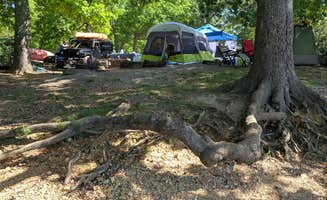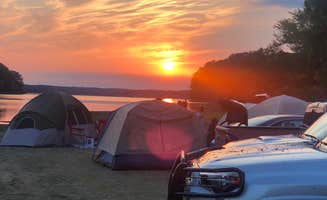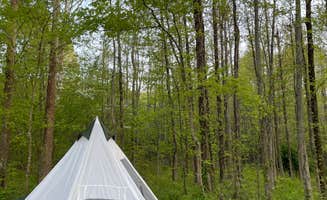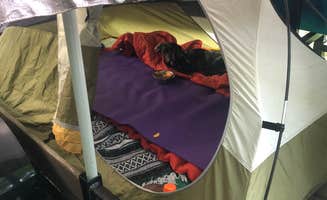Tent camping near Hardin, Kentucky centers around the inland peninsula known as Land Between the Lakes National Recreation Area, spanning 170,000 acres between Kentucky Lake and Lake Barkley. The region features predominantly oak-hickory forests with rolling terrain between 350-500 feet elevation. Summer temperatures frequently exceed 90°F with high humidity, making waterfront sites particularly valuable during peak season.
What to do
Waterfront activities: Forest Service Rd 343 offers lakeside camping with excellent swimming access. One camper noted, "Beautiful view with a nice fire pit, I was able to swim and had a great night to myself!" The road requires careful navigation as "a little washed out but not too pitted" according to another visitor.
Hiking options: The North-South Trail provides access to remote tent camping areas near Twin Lakes Campground, with sites that sit "right on the North-South trail" and blend into the natural environment. The trail runs 31 miles through the recreation area, connecting numerous camping areas.
Wildlife viewing: Visit the nearby buffalo prairie before or after setting up camp. One camper at Forest Service Rd 343 recommended "seeing the buffalo on the way in or out" as part of their camping experience. The resident bison herd can typically be viewed from your vehicle along the designated Elk & Bison Prairie driving loop.
What campers like
Secluded swimming spots: Ginger Bay Basic Camping Area offers excellent water access with campers reporting "we fished, we hiked, we kayaked!" The campground features sites "right on the water with a gravel opening beside it" where multiple tents can be set up with ample space.
Quiet weekday camping: Smith Bay Campground remains relatively empty during weekdays. A camper reported "We have been the only campers here!" after a rainy weekend scared others away. The campground features waterfront sites with "pebbly beaches" making it "perfect for kayakers."
Cost-effective options: Multiple basic campgrounds throughout Land Between the Lakes offer affordable options. At Forest Service Rd 343, a visitor explained, "Dispersed camping is a $10 fee. If you have the National Park pass you can go to a self check in campground for $5."
What you should know
Vehicle requirements: Many gravel access roads become challenging after rain. At Ginger Bay, campers advise "you will need a four-wheel drive vehicle to get down the steep gravel road to the dispersed camping area," while another notes "4x4 or awd may come in handy leaving the sites (going back up the gravel hill)."
Food storage concerns: Wildlife regularly visits campsites after dark. At Sugar Bay Campground, visitors observed that "raccoons and skunks visit the campsites nightly, so you must keep everything put away or risk a big mess."
Water planning: No potable water exists at most basic campgrounds. Campers at Redd Hollow Campground mention "I didn't pay attention to whether there was potable water, (I haul mine in) but the Dump Station just south of Golden Pond Visitor Center has potable water."
Tips for camping with families
Accessible swimming: Several campgrounds offer direct lake access for children. Sugar Bay Campground features water that's "warm in late September" with one camper noting "swimming allowed in Sugar Bay (no lifeguard)."
Private campsites: For families seeking space from other campers, Cravens Bay - LBL Lake Access offers privacy. A visitor noted the campground "basically breaks down into two areas, the low ground (first sites upon entering) and the high ground (sites further in at the top of the hill)" with "some sites scattered in-between these two areas but for the most part the largest campsites areas are the high and low ground sites."
Educational options: Incorporate visits to the nature center or historical exhibits. One camper mentioned Cravens Bay is "a great spot close to the other recreation services on offer (the Woodlands Nature station is south only a few miles)" which provides interpretive programs for children.
Tips from RVers
Campsite selection: RV campers should carefully choose sites based on terrain. At Redd Hollow Campground, a visitor with a 26-foot towable noted, "Sites are gravel and pretty level. At least half of the sites have a view of the lake."
Generator etiquette: Be considerate with generator usage in primitive areas. A Smith Bay camper warned about "a rude RVer who fired up his extremely loud generator at 11 pm and left it sputtering away until 8 am" despite rules stating "generators are only allowed during the day."
Site accessibility: Check road conditions before attempting to access remote sites. One camper at Old Boy Scout Campground advised "I wouldn't bring an RV back here to boon dock, unless you knew you were going to end up on site 5 or 6... and then it would still be a maybe" due to narrow access roads.






